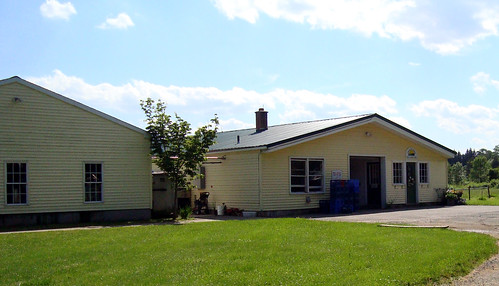I buy milk from a small dairy farm a couple of miles from my house: Trinity Farm, on Oliver Road in Enfield CT, run by Mike and Dale Smyth and their children (and even grandchildren.) The herd grazes in the pastures behind Trinity's yellow dairy barn, and the milk is pasteurized, homogenized, bottled in real glass milk bottles, and sold to the public right there at the farm. I've toured the bottling line, been nuzzled by a few friendly Holsteins, and helped carry cases of milk into the salesroom a time or two when the place was real busy and the display fridges needed restocking. I know and trust the Smyth family, and every time we pour a glass of milk or add some half-and-half to our coffee we're not only enjoying a superior product, we're helping keep local agriculture alive and well in our piece of the Valley. We know exactly where our milk comes from.
Unfortunately, not everyone can say the same thing. There might not be a dairy right down the road from you - and even if there is, most dairies sell their milk to big processors or co-ops and don't sell directly to consumers. So how do you find out where your milk (and some other dairy products) are from?
On most dairy products, you'll find a code printed on the container alongside the sell-by date. That code will reveal the source of the product, if only you had a way of decyphering it. And now you do!
On the where is my milk from? website (http://whereismymilkfrom.com/) you can find out just about everything you need to know: How to find the codes that will tell you about your dairy products; what the parts of the code mean; and how to enter them into the site for lookup. where is my milk from? makes finding the source of your milk products easy by using the FDA's IMS (Interstate Milk Shippers) List as a data source. where is my milk from? even pinpoints the location using Google Maps whenever possible.
I plugged in a code from a plastic milk jug at Costco - 25-100 - and discovered that the milk actually came from Garelick Farms in Franklin, MA (a huge New England dairy company owned by Dean Foods.)
I also poked through my refrigerator to see what else I could track down, and found a couple of surprises:
Kirkland (Costco) brand butter - I buy butter at Costco because the price is very good and I couldn't detect a quality difference between it and national favorite Land O Lakes. No surprise there - the code, 06-06, reveals that the butter is actually made by Land O Lakes Inc in Tulare CA.
Hood Sour Cream - I only buy sour cream that is made from cream and culture and perhaps some salt. I refuse to buy it if it has fillers like xanthan gum or food starch. Imagine my surprise when I found that the Hood Sour Cream code, 50-19, revealed it to have been made by the Cabot Co-Op Creamery in Cabot VT. I never buy Cabot's own brand sour cream because it contains modified food starch, guar gum, carageenan, and locust bean gum.
Cabot Whipped Cream lists plant code 37-046, which comes back to Alamana Foods Inc of Burlington NC, a huge manufacturer of private label aerosol whipped creams. How many people buy Cabot whipped cream thinking they're buying a product from a charming Vermont dairy farm?
Give it a try. Find some dairy products in your fridge - cream, half-and-half, yogurt, whatever - and plug the codes into the where is my milk from? search box. You might be surprised at what you find.
.


This is super interesting. I never knew or imagined that there could be such organization to even have such a website. I am going to go poke through my fridge right now.
ReplyDeleteThe Smyths are great people..old friends of mine. Their chocolate milk is out of this world.
ReplyDeleteI think BJ's milk is from Garelick/Franklin Farms, too.
By the way, xanthum gum is a perfectly natural product - it's sold in natural food stores as a thickener.
Christina - Xanthan gum is a natural product, but IMO it doesn't belong in sour cream.
ReplyDeleteAgreed - it's better used in products which are gluten free (provides the binding that gluten free flours don't have).
ReplyDelete